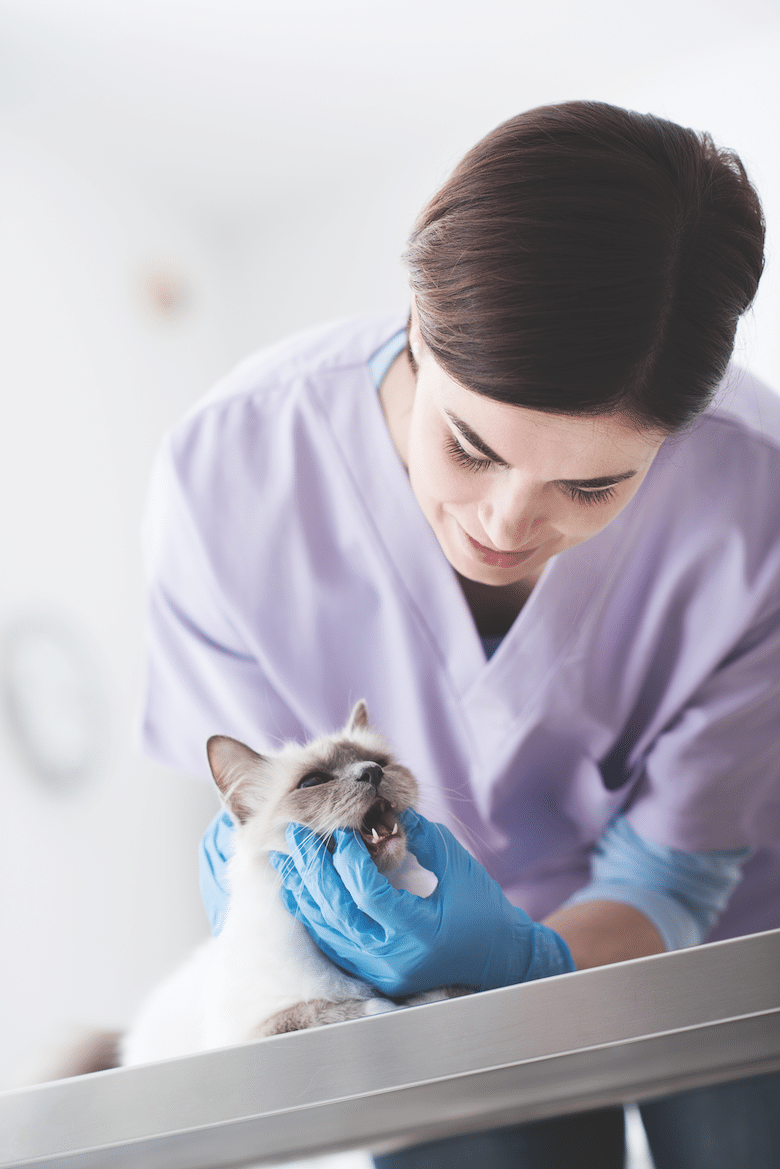
Cat dental problems are among the most common medical issues seen in cats. If unaddressed, dental problems can lead to a variety of consequences including bad breath, loose teeth, oral pain and difficulty eating.
In my experience, the most common feline dental emergency is a sudden inability to eat because of a mouth that has been severely neglected. While humans see their teeth in the mirror daily during toothbrushing, most people do not check their pet’s teeth regularly, if at all. I’ve had many cats come to my hospital for sudden loss of appetite, and upon examination I discovered an infected, diseased mouth with loose and missing teeth, bleeding gums, severe dental tartar and breath that would make your eyes water.
Invariably, the owner insists that the cat had been eating fine just until that morning and, given their stoic, resilient nature, I’m sure this is true for many of these cats. Because the mouth is painful to the point that the cat can no longer eat, this is indeed a veterinary emergency, requiring dental X-rays, a dental cleaning, tooth extraction, antibiotics and possible hospitalization with nutritional support until the cat is feeling better and can resume eating.

Here’s what you need to know about cat dental problems. Photo: zygotehasnobrain | Getty Images
Sometimes it can be challenging to tell if a cat is experiencing oral discomfort, because cats are secretive by nature. Occasionally, cats will show you that their mouth is hurting by:
At what point is a dental/oral issue considered to be an emergency? As a feline practitioner, there are several scenarios that I feel require immediate attention.
Hard tissue trauma involves injury to bone tissue and can result in fractures, often accompanied by oral pain, bleeding, loss of function and susceptibility to infection. The trauma can be from a high-energy impact (falling from a height, a bullet, BB or other projectile), a bite from another animal or a previous, progressive pathological condition that can weaken the facial bones or teeth, such as a tumor.
Soft tissue trauma tends to damage structures like the tongue, the soft palate or the oral mucosa (the tissue that lines the oral cavity). Foreign bodies (like a fish hook), impalement and caustic liquids can cause soft tissue trauma.
Initial stabilization of cats with oral trauma requires pain control and antibiotics. Definitive treatment depends on the nature of the trauma and may require surgical repair.
A broken tooth is a dental emergency. When a tooth is fractured, the pulp cavity inside becomes exposed, causing pain. Bacteria can enter the exposed pulp cavity, causing eventual infection.
A tooth with exposed pulp should be extracted promptly. Advances in veterinary endodontics have made it possible to treat and salvage some fractured teeth, and a referral to a veterinary dentist can be pursued if the client is so inclined. These treatments are costly, and most cat owners opt for extraction.
This is an infrequent problem, though it does occur occasionally. Masticatory muscle myositis, an inflammatory condition in which the chewing muscles become inflamed, can hinder the opening of the mouth. Fortunately, this condition is very rare in cats.
Tetanus is a bacterial infection that can cause all of the muscles to become rigid, including the facial muscles, preventing the mouth from opening (“lockjaw”). Tetanus is also quite rare in cats.
A retrobulbar abscess (a pocket of infection behind one of the eyeballs) can cause the eyeball to protrude. Although affected cats can open their mouth, they often resist because of the acute pain that results when they do. Thankfully, this too is uncommon. (I’ve seen one case in my career, and that was in a dog.)
An inability to close the mouth is more common than inability to open it, with the most common reason being a dislocation of the temporomandibular joint (TMJ). In simple terms, the mandible (lower jaw) pops out of the joint. This can happen from simple, accidental trauma. It results in the teeth being improperly aligned, and affected cats suddenly find themselves unable to close their mouths. This causes immediate distress and agitation, and many cats will anxiously paw at their mouth. Sedation (or full anesthesia) may be necessary to return the jaw back into the proper position.
I’ve treated a few cases of this over the years. When I was an intern (back when dinosaurs roamed the Earth) one of my professors showed me a technique in which a pencil is used as a fulcrum to pop the mandible back into place. A full description of this procedure is beyond the scope of this article, but all feline practitioners seem to know this trick, and it works like a charm. Most cats return to normal immediately after the mandible is popped back into place.
Keep up your cat’s oral health with these dental essentials, all available on chewy.com and other pet supply retailers.
The best way to treat emergency conditions in cats is to prevent them from occurring. Some oral emergencies may be unavoidable; however, regular veterinary exams that include a thorough evaluation of the mouth can help prevent dental disease from progressing to a point where emergency treatment is required.
Featured Image: demaerre | Getty Images
Read Next: Why Dental Disease Is the Most Common Problem Cats Face